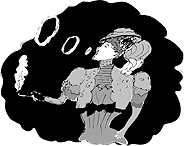on campus
Compelled to a cappella
 Effusion recently performed at the principal's skating party
Effusion recently performed at the principal's skating partyPHOTO: Claudio Calligaris |
|
As the audience in the Birks Building settles in for a night of musical entertainment, the performers of Effusion assemble on stage. Formally dressed and primed from weeks of rehearsal, the 15 students are to finally be on stage. A latecomer witnessing their tune-up might be confused however -- there isn't a single musical instrument in sight.
Unheard of three years ago at the University, a cappella vocal music groups seem to be springing up like mushrooms at McGill. In addition to Tonal Ecstasy, founded in 1998, and Effusion, founded last year, preparations are underway to organize a third group, Soulstice.
With repertoires that range from pop, to gospel, to traditional folk tunes, these groups are both talented, and entertaining.
"I think it's great, it's really taken off," said Matthew Chellew, a third year physiology student who helped found Tonal Ecstasy in 1998. Since then they have recorded a CD and performed at a number of varsity games and the McGill bookstore, and at an a cappella choir competition in Boston.
"American schools are very serious about a cappella," said Chellew. "For the most part it isn't that big here as compared to the States."
Things look promising here, though. Tonal Ecstasy auditions have drawn as many as 200 hopefuls. Last year they were only able to accept three new people.
The evident demand for a cappella groups led, last year, to the creation of Effusion. Far from being competitors, the two groups have a strong working relationship, as was evident when they both performed at the Birks Building.
"We feed off each other musically," said Effusion's Nathaniel Misri, one of the few music students in either group. He said that they appreciate having another choir at their shows to act as a critically informed audience.
Effusion's outgoing president, Jenna Robertson, also participated in her high school's a cappella group in the States. The fourth year arts student formed the group with a few friends last year, and they have since performed at McGill and in the U.S.
"As a university experience it's wonderful," said Robertson. "Not only do we make wonderful music, but we're a strong social unit. We're really a family."
Sometimes literally. This semester McGill will be blessed with a third a cappella group, Soulstice. One of its founders, Mara Dasco, 18, had come to McGill from her native Texas determined to join her brother Matthew in Tonal Ecstasy.
"I auditioned for them... I got a call back but I didn't make it in," says the first year arts student. "I was pretty set on this, so another guy who also didn't get in and I decided to start our own."
The group already has a membership of 10, and is looking forward to performing soon. Asked if McGill can support another a cappella group, Dasco points out that smaller schools in the States have as many as 18 groups doo-wopping on campus.
"There's always room for more," she said. "I think there's room for even five more."
Blasts from the past
 |
|
Gerald Bull's "Supergun." From the High Altitude Research Project
It's a little chilling, seeing the hand-drawn illustrations, numbers and "sketch of spray pattern" that Gerald Bull put in his 1961 technical report, "On the Impacts of Pellets on Thin Plates."
For the moment, that document by the brilliant ballistics designer, who taught mechanical engineering at McGill from 1961 to 1967, then became mired in designing arms for Iraq and was assassinated in 1990, purportedly by Israeli secret service agents, is but a flimsy few pages, staple-bound in a tattered red cardboard cover.
But that will soon change when Hussieni Azad, a mechanical engineering student in the Work Study program, scans the document, then sends it electronically to digital collections librarian David McKnight so that it may be preserved forever on the web site of the Mechanical Engineering Reports Digitization Project.
It was due to the sorry state of the technical reports of Bull and many other professors of mechanical engineering, dating from the 1960s and '70s, that librarians at the Physical Sciences & Engineering Library, Marika Asimakopulos, Darlene Canning and Elizabeth Gibb, initiated the project. To date 210 of the 372 reports are online.
"Over the years, we've been asked for these reports and they were in awful shape, falling apart and getting lost," notes Asimakopulos. "People in shelving always had an awful time with them."
For non-mechanical engineers, the documents are interesting if only for the light they cast on a dramatic time in McGill's history. Many of the researchers who wrote the earlier reports worked in such groups as the Gas Dynamics Laboratory, the Hypersonic Propulsion Research Laboratories and the Space Research Institute, sometimes, as in the case of Bull, in collaboration with such entities as the United States Army.
The web site for the Mechanical Engineering Technical Reports is imago.library.mcgill.ca/pse/
No gal's pal
 Illustration: Tzigane
Illustration: Tzigane |
|
Fighting against devices of death is Heidi Rathjen's specialty and next week she'll be at McGill to tackle one of the world's biggest killers: cigarettes.
The co-founder and campaign director for the Quebec Coalition for Tobacco Control (QCTC), Rathjen will give a talk at McGill on January 18 entitled: "The Effects of the Tobacco Industry and its Products on Women."
If Rathjen's name sounds familiar, that's because as executive director and co-founder of the Coalition for Gun Control from 1991-96, she successfully lobbied the Canadian government to pass legislation curbing the use of firearms across the country. Her efforts helped spawn Bill C-68, or Canada's gun control law.
Since then, as QCTC co-founder, Rathjen has tackled smoking and advocated for the passage of Quebec's Tobacco Act, or Bill 444. Ratified in 1998, the law prohibits smoking in many public places and is considered one of the toughest pieces of non-fiscal anti-tobacco legislation in Canada.
That resumé has made Rathjen a popular public speaker to dissect the endless ills of smoking.
During her McGill talk, she intends to zero in on women and how tobacco use produces gender-specific health hazards: smoking to remain thin, smoking during pregnancies, and how a mother's second-hand smoke affects her children.
She'll also examine the ways in which the tobacco industry, through its advertising, influences women to light up. "Tobacco companies target men, minorities, the rich or the poor through different modes of advertising," she says. "When women are targeted, they are manipulated into buying cigarettes as vehicles of emancipation, which they're not. Cigarettes are killers."
Heidi Rathjen's January 18 talk will be at 4 pm in room 270 of the Arts Bldg. Her talk is sponsored by the McGill Centre for Research and Teaching on Women. For more information, please call 398-3911.
Saved from the brain drain?
What keeps young Canadian researchers from the temptations of well-moneyed careers in the United States? Quality of life? Quality of research facilities?
Regarding the former, McGill has the advantage of location, location, location. Regarding research facilities ... Well, until recently, adequate space and equipment weren't always a given.
But this is changing, thanks, in part, to a little flaunted program of the Canada Foundation for Innovation, known as the New Opportunities Fund. Last month, the CFI celebrated the success of 25 new McGill faculty members who have benefited from the most recent round of grants.
Lunch at the Faculty Club and a CFI certificate and pin comprised the booty.
"This is the best line of defence to losing talent to the U.S," says Robert Marchessault, co-ordinator of McGill's CFI applications and EB Eddy Professor at the Pulp and Paper Research Centre. Marchessault lauds the program for allowing the University "to recruit the sort of talent that you want," explaining that the NOF allocates "virtual money" to universities based on the institution's overall record for receiving research grants. McGill, the University of Toronto, Université de Montréal and UBC get the lion's share.
Since the program began in 1998, McGill has received $7 million, which is to last until the end of this year.
Vice-Principal (Research) Pierre Bélanger allocates the money to the Faculties of Medicine, Engineering, Science and Agricultural and Environmental Sciences (the program's main targets) while keeping some in reserve for proposals from the Faculties of Arts and Management. To date, a total of 38 projects involving 54 researchers have been funded and the program has been extended from the original end date of 2001 to 2005.
Like the regular CFI grants, New Opportunities funds infrastructure only, including equipment, buildings or adaptations of existing space. Open to faculty who have been at the University for a maximum of 18 months, the program finances 40% of the cost of the project, provided the project is first approved by the Quebec Ministry of Education, which also puts up 40%, leaving the researcher to find the rest either from within the University or in the private sector.

